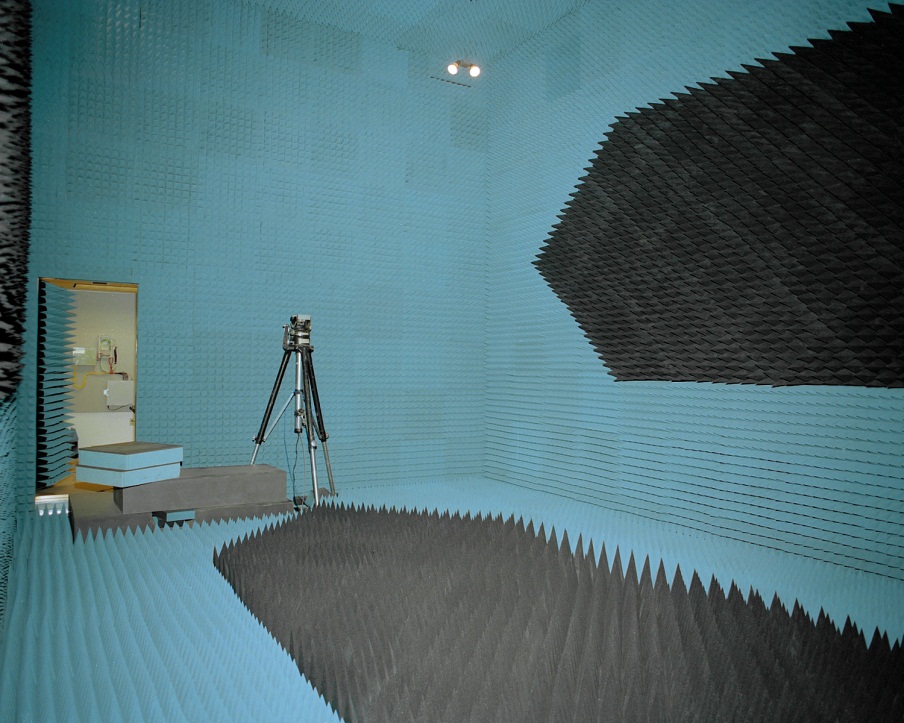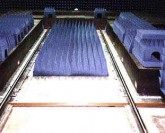[tab:Description]

Near-Field Chambers
Most antenna measurements need to be carried out in the far field; that is, the test antenna should be illuminated by a plane wave. Typically this is carried out by providing sufficient separation between the source and the AUT so the spherical wave approaches a plane-wave character.
Near-Field chambers are an excellent alternative to traditional far-field ranges; testing that can be accomplished on a far-field range can be accomplished on a Near-Field test range. This method of testing allows an operator to employ an indoor anechoic test chamber at a reasonable cost and avoid the problems associated with weather and security concerns often encountered when using an outdoor test range.
Near-Field Methodology
This short range test method, (Near-Field) has become widespread and can be used for single antennas or multi-element phased arrays.
This process involves sampling the field near the face of the radiating aperture, (using a small RF probe 4-10 wavelengths form the antenna structure) and then using a near-field to far-field transform to compute and transfer the properties using Fourier techniques into the far-field properties of the aperture. The far-field data can then be displayed in the same formats as conventional far-filed antenna measurements.
At first glance, the setup of a Near-Field system is very intricate; however with our team coordinating the design, incorporating the equipment package and constructing the chamber the process becomes very simple.
Near-Field Chamber Designs
A Near-Field chambers footprint depends on several factors; 1) the Near-Field test method being used, 2) the size of the equipment under test and 3) the lowest frequency being tested.
There are typically (3) different geometries used in Near-Field test systems, planar, cylindrical, and spherical.
Planar Near-Field Method – With planar near-field scanning, the probe usually is scanned in X and Y linear coordinates over the aperture of the test antenna. A large planar scanner is used to move the probe over a very accurate plane located in front of the test antenna’s aperture. Once aligned to the scan plane, the test antenna is not moved during the collection of the near field data. Planar near-field provides limited angular coverage of the test antenna’s field due to the truncation caused by the scanner’s dimensions.
Cylindrical Near-Field Method – For this method the probe typically is scanned in one linear dimension using a single axis linear positioner. The test antenna is stepped in angle on a rotary axis oriented parallel to the linear axis. The resulting scan describes a cylindrical surface around the test antenna. Cylindrical near-field scanning can provide complete angular coverage of the test antenna’s field in one plane. The orthogonal plane has limited angular coverage due to truncation caused by the finite length of the linear scanner.
Spherical Near-Field Method – Spherical near-field scanning normally involves installing the test antenna on a spherical scanning positioner. The probe antenna is normally fixed in space. The test antenna is normally scanned in one angular axis and stepped in an orthogonal angular axis. The resulting data is collected over a spherical envelope surrounding the test antenna. Full or nearly-full coverage of the test antenna’s radiating field can be evaluated with this type of near-field system.
Oftentimes shielding effectiveness is not a primary concern and stick-built construction providing ~75dB of shielding effectiveness is adequate. However, if additional SE is required modular panel and welded systems are available.
Cuming Microwave’s C-RAM SFC broadband RF absorbers are specially designed to provide premium performance in anechoic chambers at both normal and off normal incidence angles and can safely withstand continuous field intensity of up to 400 V/m and intermittent field intensity of up to 750 V/m.
Turnkey Systems
Cuming-Lehman Chambers is confident that our team provides an overall fully compliant technical package that offers you the lowest risk, budget friendly solution while meeting all your testing requirements. All of our products are designed to work together for maximum efficiency and performance.

For a quote on a Near Field Chamber contact us today!
[tab:Chamber Construction / Installation]
Chamber Construction / Shielding Options
- Stick Built
- Modular
- Welded
Absorber Materials
- Broadband Foam Absorber
- Mounting Methods
- Velcro Attachment
- Spray Adhesive
- Clip and Rail (Mechanical Attachment)
Chamber Accessories
- Lighting
- Filters
- CCTV and Intercom Systems
- Doors and Ramps
- HVAC Systems
- Fire Detection/Suppression Systems
- Test Equipment

